USATF Cross Country Club National Championship – 12/13/14
Tom Steenkamer submitted a race recap of the USATF Club Nationals before settling in for his long winter’s nap. Enjoy Tom! You’ve certainly earned it.
This event marked the first time the club had participated in a major USATF event on such a grand scale. We have a few members who had previously participated as individuals in USATF championships but for most of them this was a new experience in many ways. Many of the 64 club members had never run cross country in high school or college. We did have a few ringers who were prior All-State runners as well as several with collegiate experience at the Division 1, 2 and 3 levels.
We traveled via charter bus from the Wilmington riverfront to Lehigh University (in Bethlehem, PA) which made the day seem more like a collegiate team road trip. Our home for the day would be a heated tent provided by the MidAtlantic USATF. The tent proved both large and warm enough for folks to stretch, relax and even catch a nap.
The dusting of snow the Saucon Valley area received early that week had melted leaving a few soft spots but otherwise the grass course was in fine shape. The only exception to that was an ~200m section around the 1k mark where the course passes by the construction site for a new softball field. No grass there and a nice slick coating of mud but thankfully this area did not have significant impact on any of the races. Women competed on the traditional Paul Short 6k course, and the men followed a modified version of this same course for their 10k race.
PCVRC sent 64 runners to the line that cool December morning. Members ranged in age from 21 to 82 competing as teams in the 4 races. PCVRC had teams in both the men’s (2 teams) and women’s open races. In the masters races we fielded teams in 10-year age groups from 40 thru 70 in the men’s race and 40 thru 60 in the women’s race. Standard cross-country scoring applied – order of finish for the top 5 or in some of the master’s age groups (men’s 70 and all women’s masters) top 3 finishers creating a team score.
Race Field Sizes
Women’s Masters: 270
Men’s Masters: 633
Women’s Open: 387
Men’s Open: 615
Total: 1905
PCVRC Team Results
(Editorial note – our men’s 60+ team did not have enough members to score as a team.)
Men’s Open A 25th
Men’s 40 A 27th
Men’s 50 A 6th
Men’s 70 A 4th
Men’s Open B 53rd
Men’s 50 B 24th
Men’s 70 B 6th
Women’s Open A 24th
Women’s 60 A 4th
Women’s 40 A 12th
Women’s 50 A 15th
Women’s 40 B 29th
Individual Highlights
(Editorial note – Listed age-group individuals based on top-20 finish in their respective age group.)
Men’s open:
Andy Weaver 61st overall
Women’s masters:
Kirsten Belair 14th overall
Women’s masters age group:
Kirsten Belair 10th
Diane Kukich 10th
Carol Giampietro 14th
Carole Feole 17th
Beth Howlett 17th
Men’s Masters age groups:
John Schultz 2nd
Chuck Crabb 5th
Greg Cauller 7th
Doug Ridge 10th
Tom Steenkamer 12th
Bob Callahan 16th
Frank Owczarek 17th
Don Coats 18th
Tim Schuler 19th
Chuck Hall 19th
Closing Thoughts
What other sport can anyone who pays the entry fee get on the same field as world-class athletes and compete regardless of age or ability!?!
Special thanks to the Pike Creek Valley Running Club board for their support that made this day such a success. Congratulations to everyone who joined us and Thank You for participating. Wishing everyone a healthy 2015 and I hope to see many more of you out at some of next year’s Mid Atlantic USATF road or trail races!
Happy New Year! Big things are in store for our club this year!
John Schultz wrote a history of the Brooklyn Bridge I wanted to make sure got included. Several things I didn’t know about the bridge and the builder! Thanks John!
Leprechaun Leap 5k
Joel Schiller has arranged a special PCVRC-only rate of $20 for the Leprechaun Leap 5k on March 7th, benefiting the Ministry of Caring. You must register by mail and the envelope must be postmarked by January 1st. (Online registrations won’t get the discount.) Here is the universal entry form to print out and mail in.
You can pay with cash or check and mail the form to:
Races2Run
P.O. Box 24
Montchanin, DE 19710
See you there!
Central YMCA Indoor Triathlon/Duathlon
Joel Schiller is the race director for a very unique race. There are three stages: a 20-lap pool swim, a 15-mile SPIN bike ride and a 3-mile treadmill run. Start time slots run between 10:00 AM and 1:30 PM. You get to choose your start and the order you do the stages in. Transition times do not count so you’re not penalized if your transitions are slower than most. If you do the duathlon you can choose from any of the three stage types!
Registration is only $20 (until January 31st, $25 afterward and day-of) and you get a tech t-shirt and a finisher’s medal! Here’s the link to sign up online. (Online registration closes on Feb. 26th. Day-of registration will be available, starting at 8 AM.)
White Clay Creek Trail Closures
I saw a Facebook post about temporary trail closures due to various hunting seasons. Thought I would pass it along since we use the park quite a lot.
The following trails will be closed to the public on December 19 and 20 and from January 17 – 24 during shotgun deer hunting season:
Twin Valley Trail (Carpenter) east of Arc Corner Monument and Wells Lane
Bryans Field Trail (Possum Hill)
Mountain Bike Skills Trail (Possum Hill)
Charles Bailey Trail (Preserve) between Thompson Station Road and the Delaware / Pennsylvania state line
Cart Road Trail (Preserve)
Boundary Line Trail (Preserve) between Cart Road and Corner Ketch Road
The Chestnut Hill Trail (Judge Morris) is posted with archery season warning signs. The Chestnut Hill Trail is open to the public when archery season warning signs are posted.
The Pomeroy Trail between the Pomeroy Pedestrian Bridge and Hopkins Road will be closed to the public on January 06 during a managed hunt.
Brooklyn Bridge
In September I posted a picture of me walking on the Brooklyn Bridge. (I had just bought it and wanted to see what I got for my $20. What a deal!) John Schultz responded with several vignettes about the bridge’s history, including its builders. I wanted to share them with the club.

From John:
In the photo you’re facing New York (that’s what an old Brooklynite like myself calls Manhattan), with Brooklyn showing in the background of the photo. I’ve crossed the Bridge many times, and I remember when it had elevated trains and trolleys on it, and the roadway was paved with wooden blocks.
A suggestion for your next crossing of the East River: walk the Manhattan Bridge. Its walkway is on the outside (unlike the Brooklyn’s, which is between (though higher than) the two roadways). This gives you a much better view. At the Brooklyn end it starts near the Brooklyn Bridge. The New York end takes you to Chinatown and the diamond-dealing center of the USA.
I knew an old man who walked across the Bridge on the day it opened in 1883. (By-the-way its original and full name is the New York and Brooklyn Bridge). When built it was the longest suspension bridge in the world.
The Bridge towers rest on WOODEN caissons. On the New York side the caissons rest on mud because bedrock was too deep to drill down to.
The ironwork for the Bridge was made at the Edge Moor Iron Co., located just east of East Side Wilmington along the Delaware River, which was founded in 1869 and was in business until about 1946. I’ve heard that the Bridge requires less maintenance than the nearby Manhattan, Williamsburg and Queensborough Bridges, built in 1909. 1909, and 1903 respectively.
When the Brooklyn Navy Yard was operating, the battleships’ masts had to be lowered to be able to get under the Bridge.
The Bridge was built by Washington Augustus Roebling and his father. The steel wire was spun at their plant in Roebling, NJ, near Burlington.
I then asked John about a bridge I found in Lackawaxen, PA (on the PA/NY border) that was supposedly built by the Brooklyn Bridge builder. The names didn’t line up. (As John noted above Washington Roebling built the Brooklyn Bridge and the sign I found said Daniel Roebling.)
Below are pictures of the bridge, signs, and John’s response.
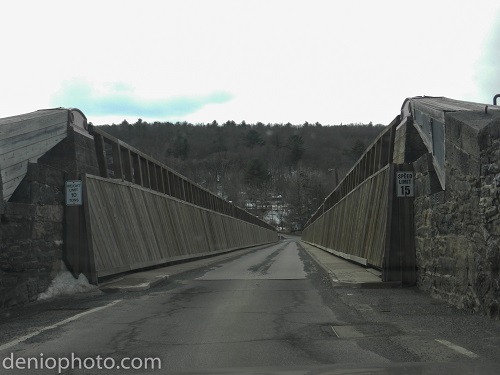
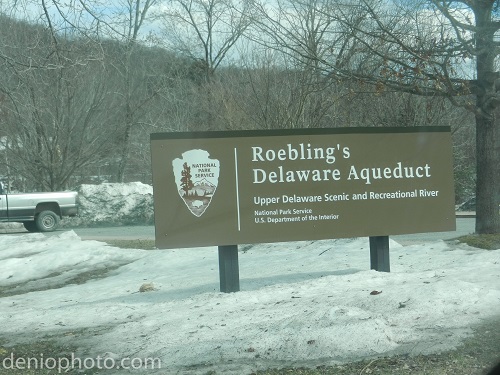
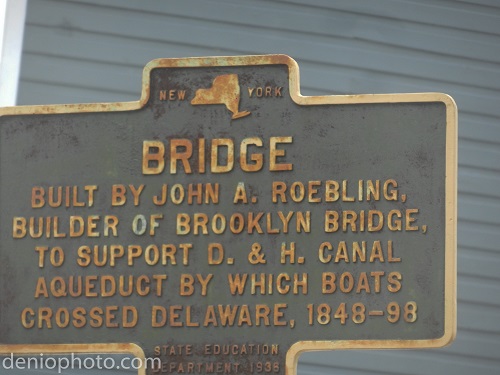
The Brooklyn Bridge was finished by Washington Augustus Roebling rather than his father. The father injured his foot (boarding the Fulton Ferry in Brooklyn), refused to have it treated, and died from infection. SO BE CAREFUL AROUND THE BRIDGE!
John was the father who designed the bridge. Washington Augustus was the son who directed its construction. I may be wrong but the Lackawaxen Bridge may have been John’s first suspension bridge.
The Delaware Aqueduct at Lackawaxen is the oldest existing wire-suspension bridge in the USA. After the Delaware and Hudson Canal closed in 1898 (after 70 years in service), the bridge became a private vehicular bridge until 1970. Now it’s owned by the Park Service and I think still carries traffic.
I’ve often run in the 11.8-mile Roosa Gap Roller Coaster Run, near Wurtsboro, NY, 4 miles of which are along the towpath of the Canal. (Miles 5 and 6 are an 800-foot road climb to the crest of the Shawanagunk Mountains, but that’s another story). The D&H Canal, like most canals starting in Pennsylvania, was built to carry coal to cities like New York and Philadelphia.
Race Results, Reviews and Accomplishments:
Kelly Jones took 3rd place in her age group at the Surfin’ Snowman 5-Miler in Bethany Beach this past Saturday. She finished in 38:22, missing her PR by only 12 seconds! Awesome job Kelly!
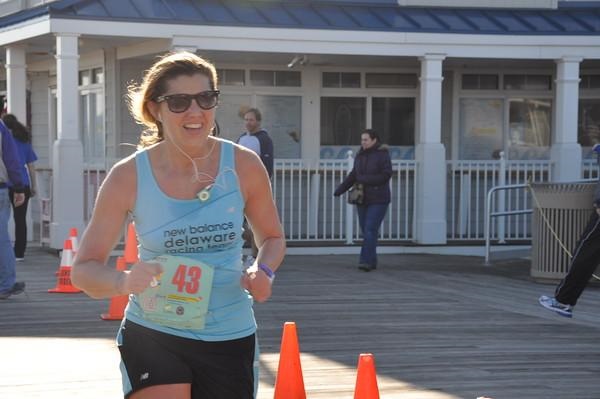
(Photo Credit: Kelly Jones)
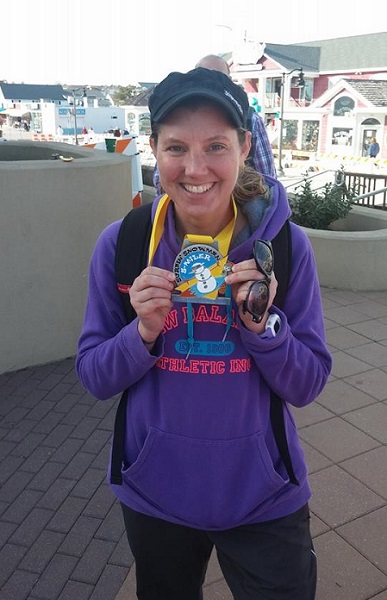
(Photo Credit: Kelly Jones)
Surfin’ Snowman 5-Miler
(December 27th – Bethany Beach, DE)
Kelly Jones 38:22